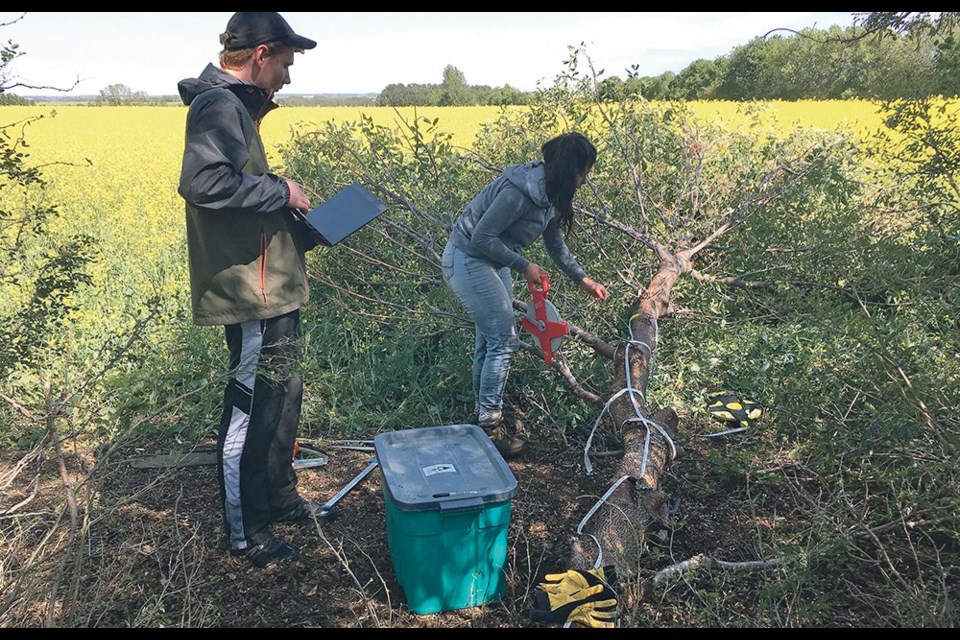INDIAN HEAD — Shathi Akhter is an agroecosystems scientist with Agriculture Canada at Indian Head, Sask. She cited information that shows, of the more than 51,000 kilometres of shelterbelts within Saskatchewan, 2,490 km were lost in the eight years between 2008 and 2016 — a five per cent drop.
Before firing up the dozer, Laroque urges farmers to take a lesson from the past season, and from previous generations. He and his team have spent more than 10 years gathering data for a shelterbelt evaluation and planning tool from farms across Saskatchewan.
The conversations are telling. While younger farmers can be ambivalent about shelterbelts, the long-term view of their parents and grandparents is much different.
“Older people would always say, ‘Keep the trees. Keep those trees. You don’t realize what they’re doing,’” Laroque said. “When you’re looking back on a lifetime, (you can see) they’re helping.”
Farmers’ attitudes toward their trees is generally positive. A 2014 survey by Brandon University’s Rural Development Institute showed that the vast majority of livestock producers rated the importance of their shelterbelts as “very important,” or “important.” Crop producers were less enthusiastic, but well over half had similar positive sentiments.
Knowledge from both Laroque’s and Ahkter’s research may help make the case against removing shelterbelts and for planting even more.
Trees have value, but it’s not something you can compare apples-to-apples with an annual cash crop. But in a drought year, their value is readily apparent. Laroque said trees catch winter snows, slow down drying winds and protect crops from the worst of the summer sun.
“What we’ve measured, there’s a really good moisture content in the soil to about three heights of your shelterbelt. So if the shelterbelt is 10 metres high, it buffers 30 metres in either direction.”
Walk out into a crop at the end of a drought year, he said, and you will see the crop is higher and headed out more near the shelterbelts. Test the soil and it will be healthier near the trees, with more organic matter.
“One of the things those shelterbelts are doing, whether you realize it or not, is they are improving the soil,” Laroque said.
While trees do compete with crops, this effect is limited. Akhter’s research with shelterbelt intercropping shows the “competitive zone” is about two metres, while crops in the 11-metre “complementary zone” between the rows of trees actually benefit from their presence. This includes better nutrient cycling, nitrogen mineralization, soil organic carbon and earthworm activity.
Akhter is also looking at shelterbelts as crops in their own right, by choosing fruit and nut-bearing species such as buffaloberry, seabuckthorn, hazelnut, and haskap. In a presentation on the subject, she said that while initial harvests won’t happen for years, there can be other benefits in the meantime.
“Being nitrogen-fixing crops, buffaloberry and seabuckthorn will contribute significant quantities of nitrogen to the soil and could be a considerable advantage, especially on marginal lands.”
This type of approach would create shelterbelts as a crop to be harvested rather than a static asset. This would require a rethink from farmers. In the 2014 Brandon University survey, the top barriers to planting and retaining shelterbelts were labour, time and costs associated with planting and maintaining the trees.
If interest in Laroque’s online resource is any indication, there are a lot of farmers willing to take this step. He reports that there have been more than 50,000 visits to the site since it was launched last March and it continues to draw interest.
The Shelterbelt DSS planner is based on 10 years of data covering every soil zone in Saskatchewan. Farmers can look at their own land location and get recommendations on what tree species to plant and in which direction the shelterbelts should be oriented in order to get the maximum benefit.
Since it uses data-heavy satellite maps, Laroque said it is best used on a computer with a landline, since a robust internet connection is needed.
Tree selection is also important since the prairie climate is at the extreme edge of survivability for some species. The research team drew on the records of the PFRA Shelterbelt Centre in Indian Head to find out which species had been shipped where over the decades and then how well they they survived. For example, some trees such as white spruce only survived in more southern locations where farmers had put a lot of care into them.
Another aspect for shelterbelts, and for Shelterbelt DSS, is carbon. Trees are great at capturing and sequestering carbon, and if this can be measured, it can be worth something to the farmer. Laroque noted that the major parties in the latest federal election all have a position on carbon as having value, and several provinces already have carbon credit systems in place.
From the standpoint of public perception, shelterbelts also offer a chance for farmers to push back against negative narratives around agriculture and climate change.
“On one side, running tractors, taking short term crops off, so you’re a carbon balance is kind of negative,” Laroque said. “If you flip it over and say ‘I have a whole line of shelter belts,’ you say, ‘well those trees are actually sequestering more carbon than we’re putting up the exhaust.’”
Over the long term, he said trees are a legacy asset, adding long-term value to any given parcel of land both for agronomic benefits and for combatting climate change.
“That carbon is actually worth something or worth something in some provinces, not yet in ours, but it’s worth something around the world. It’s going to be,” Laroque said. “At least we’re headed in that direction.”




